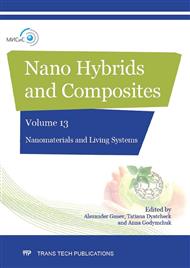[1]
W. Wei, W. Zhaohui, Y. Taekyung, J. Changzhong, K. Woo-Sik, Recent progress on magnetic iron oxide nanoparticles: synthesis, surface functional strategies and biomedical applications, Sci. Tech. Adv. Mater., 16 (2015) 023501.
Google Scholar
[2]
M. Colombo, S. Carregal-Romero, M.F. Casula, L. Gutierrez, M.P. Morales, I.B. Bohm, J.T. Heverhagen, D. Prosperi, W.J. Parak, Biological applications of magnetic nanoparticles, Chem. Soc. Rev., 41 (2012) 4306-4334.
DOI: 10.1039/c2cs15337h
Google Scholar
[3]
K. Aguilar-Arteaga, J.A. Rodriguez, E. Barrado, Magnetic solids in analytical chemistry: a review, Anal. Chim. Acta, 674 (2010) 157-165.
DOI: 10.1016/j.aca.2010.06.043
Google Scholar
[4]
J. He, M. Huang, D. Wang, Z. Zhang, G. Li, Magnetic separation techniques in sample preparation for biological analysis: a review, J. Pharm. Biomed. Anal., 101 (2014) 84-101.
DOI: 10.1016/j.jpba.2014.04.017
Google Scholar
[5]
J.S. Miller, Drillon M., Magnetism: Molecules to Materials V, Wiley-VCH, Weinheim, (2005).
Google Scholar
[6]
K.M. Krishnan, A.B. Pakhomov, Y. Bao, P. Blomqvist, Y. Chun, M. Gonzales, K. Griffin, X. Ji, B.K. Roberts, Nanomagnetism and spin electronics: materials, microstructure and novel properties, J. Mater. Sci., 41 (2006) 793-815.
DOI: 10.1007/s10853-006-6564-1
Google Scholar
[7]
T. Neuberger, B. Schöpf, H. Hofmann, M. Hofmann, B. von Rechenberg, Superparamagnetic nanoparticles for biomedical applications: Possibilities and limitations of a new drug delivery system, J. Magn. Magn. Mater., 293 (2005) 483-496.
DOI: 10.1016/j.jmmm.2005.01.064
Google Scholar
[8]
A.E. Urusov, A.V. Zherdev, B.B. Dzantiev, Use of gold nanoparticle-labeled secondary antibodies to improve the sensitivity of an immunochromatographic assay for aflatoxin B1, Microchim. Acta, 181 (2014) 1939-(1946).
DOI: 10.1007/s00604-014-1288-4
Google Scholar
[9]
A.E. Urusov, A.V. Petrakova, M.V. Vozniak, A.V. Zherdev, B.B. Dzantiev, Rapid immunoenzyme assay of aflatoxin B1 using magnetic nanoparticles, Sensors, 14 (2014) 21843-21857.
DOI: 10.3390/s141121843
Google Scholar
[10]
S. Laurent, D. Forge, M. Port, A. Roch, C. Robic, L.V. Elst, R.N. Muller, Magnetic iron oxide nanoparticles: synthesis, stabilization, vectorization, physicochemical characterizations, and biological applications, Chem. Rev., 108 (2008).
DOI: 10.1021/cr068445e
Google Scholar
[11]
J. Ederveen, A Practical Approach to Biological Assay Validation, Progress, Project Management and Engineering, the Netherlands, Hoofddorp, (2010).
Google Scholar
[12]
R. Gao, J. Li, S. Han, B. Wen, T. Zhang, H. Miao, Q. Zhang, Magnetisation behaviour of mixtures of ferrofluids and paramagnetic fluids with same particle volume fractions, J. Exp. Nanosci., 7 (2011) 282-297.
DOI: 10.1080/17458080.2010.524668
Google Scholar
[13]
T. Hyeon, Chemical synthesis of magnetic nanoparticles, Chem. Commun., (2003) 927-934.
Google Scholar
[14]
J. -M. Montenegro, V. Grazu, A. Sukhanova, S. Agarwal, J.M. de la Fuente, I. Nabiev, A. Greiner, W.J. Parak, Controlled antibody/(bio-) conjugation of inorganic nanoparticles for targeted delivery, Adv. Drug. Deliv. Rev., 65 (2013) 677-688.
DOI: 10.1016/j.addr.2012.12.003
Google Scholar
[15]
L. Zhang, R. He, H. -C. Gu, Oleic acid coating on the monodisperse magnetite nanoparticles, Appl. Surf. Sci., 253 (2006) 2611-2617.
DOI: 10.1016/j.apsusc.2006.05.023
Google Scholar
[16]
J. Xie, J. Huang, X. Li, S. Sun, X. Chen, Iron oxide nanoparticle platform for biomedical applications, Curr. Med. Chem., 16 (2009) 1278-1294.
DOI: 10.2174/092986709787846604
Google Scholar
[17]
A.V. Petrakova, A.E. Urusov, A.V. Zherdev, B.B. Dzantiev, Comparative study of strategies for antibody immobilization onto the surface of magnetic particles in pseudo-homogeneous enzyme immunoassay of aflatoxin B1, Mosc. Univ. Chem. Bull., 71 (2016).
DOI: 10.3103/s0027131416010119
Google Scholar
[18]
I. Safarik, Safariková, M., Forsythe, S.J., Magnetic techniques for the isolation and purification of proteins and peptides, Biomagn. Res. Technol., 2 (2004) 1-17.
Google Scholar
[19]
M. Franzreb, Siemann-Herzberg, M., Hobley, T.J., Thomas O.R., Protein purification using magnetic adsorbent particles, Appl. Microbiol. Biotechnol., (2006) 505-516.
DOI: 10.1007/s00253-006-0344-3
Google Scholar
[20]
I. Safarik, Safariková, M., Magnetically modified microbial cells: A new type of magnetic adsorbents, China Particuology, (2007) 19-25.
DOI: 10.1016/j.cpart.2006.12.003
Google Scholar
[21]
A.V. Petrakova, A.E. Urusov, A.V. Zherdev, B.B. Dzantiev, Magnetic ELISA of aflatoxin B1 - pre-concentration without elution, Anal. Methods, 7 (2015) 10177-10184.
DOI: 10.1039/c5ay02386f
Google Scholar
[22]
J.M. Ryan, Extraction Efficiency Studies for Mycotoxins in Naturally Contaminated Commodities, Mycotoxin Prevention and Control in Agriculture, American Chemical Society, 2009, pp.223-236.
DOI: 10.1021/bk-2009-1031.ch015
Google Scholar


